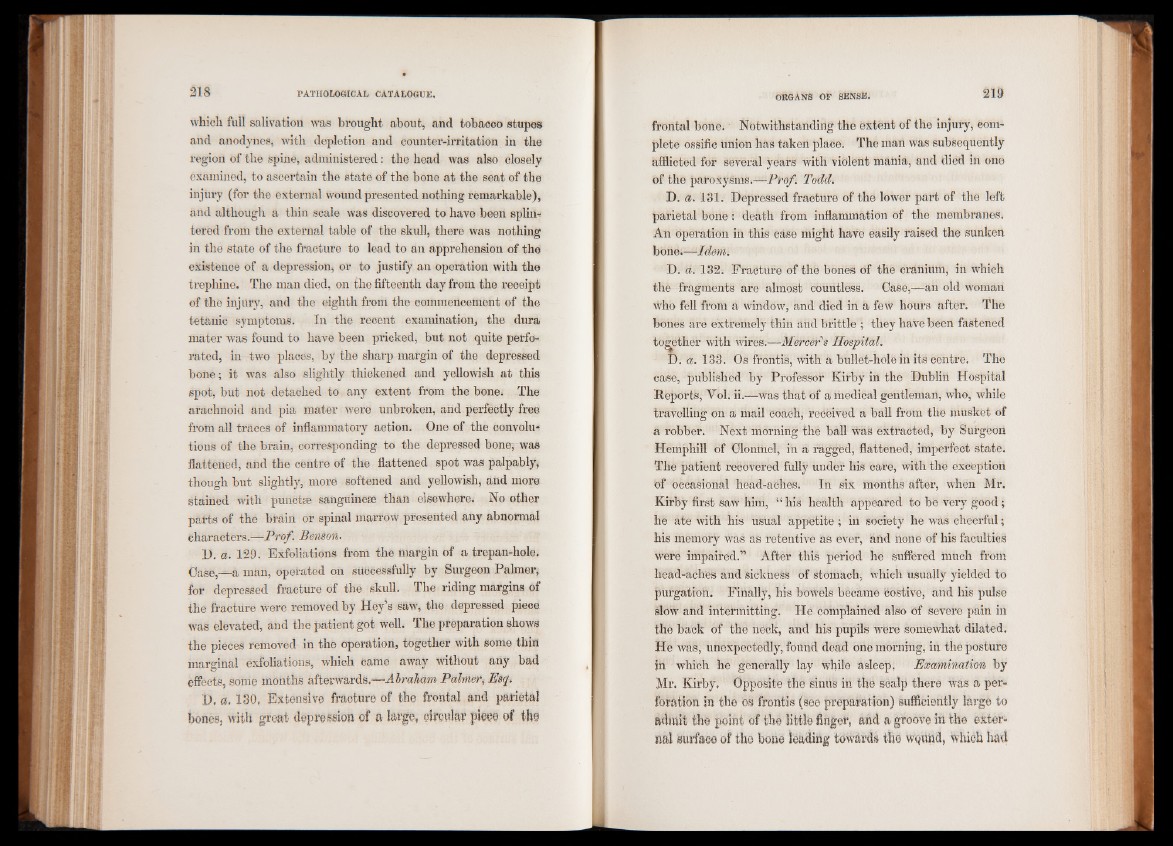
which full salivation was brought about, and tobaooo stupes
and anodynes, with depletion and counter-irritation in the
region of the spine, administered: the head was also closely
examined, to ascertain the state of the bone at the seat of the
injury (for the external wound presented nothing remarkable),
and although a thin scale was discovered to have been spline
tered from the external table of the skull, there was nothing
in the state of the fracture to lead to an apprehension of the
existence of a depression, or to justify an operation with the
trephine. The man died, on the fifteenth day from the receipt
of the injury, and the eighth from the commencement of the
tetanic symptoms. In the recent examination, the dura
mater was found to have been pricked, but not quite perforated,
in -two places, by the sharp margin of the depressed
bone; it was also slightly thickened and yellowish at this
spot, but not detached to any extent from the bone. The
arachnoid and pia mater were unbroken, and perfectly free
from all traces of inflammatory action. One of the convolutions
of the brain, corresponding to the depressed bone, was
flattened, and the centre of the flattened spot was palpably,
though but slightly, more softened and yellowish, and more
stained with punctse sanguinese than elsewhere, No other
parts of the brain or spinal marrow presented any abnormal
characters.—Prof. Benson.
1 ). a. 129. Exfoliations from the margin of a trepan-hole.
Case,-^-a man, operated on successfully by Surgeon Palmer,
for depressed fracture of the skull. The riding margins of
the fracture were removed by Hey’s saw, the depressed piece
was elevated, and the patient got well. The preparation shows
the pieces removed in the operation, together with some thin
marginal exfoliations, which came away Without any bad
effects, some months afterwards.—Abraham Palmer, Esq.
D. a. 130, Extensive fracture of the frontal and parietal
bones, with great depression of a large, circular piece of the
frontal bone, • Notwithstanding the extent of the injury, complete
ossific union has taken plaCe. The man was subsequently
afflicted for several years with violent mania, and died in one
of the paroxysms.—Prof. Todd.
D. a. 131. Depressed fracture of the lower part of the left
parietal bone : death from inflammation of the membranes.
An operation in this case might have easily raised the sunken
bone.—Idem.
D. a. 132. Fracture of the bones of the cranium, in which
the fragments are almost countless. Case,—an old woman
Who fell from a window, and died in a few hours after. The
bones are extremely thin and brittle ; they have been fastened
together with wires.—Mercer's Hospital.
D. a. 133. Os frontis, with a bullet-hole in its centre. The
case, published by Professor Kirby in the Dublin Hospital
Deports, Yol. ii.—was that of a medical gentleman, who, while
travelling on a mail coach, received a ball from the musket of
a robber. Next morning the ball was extracted, by Surgeon
Hemphill of Clonmel, in a ragged, flattened, imperfect state.
The patient recovered fully under his care, with the exception
of occasional head-aches. In six months after, when Mr.
Kirby first Saw him, “ his health appeared to be very good;
he ate with his usual appetite; in society he was cheerful;
his memory was as retentive as ever, and none of his faculties
were impaired.” After this period he suffered much from
head-aches and sickfaess of Stomach, which usually yielded to
purgation. Finally, his bowels became costive, and his pulse
sloW and intermitting, He complained also of severe pain in
the back of the neck, and his pupils were somewhat dilated.
H e was, unexpectedly, found dead one morning, in the posture
In which he generally lay while asleep. Examination by
Mr. Kirby, Opposite the siniis in the scalp there was a perforation
in the os frontis (see preparation) sufficiently large to
admit the point of the little linger, and a groove in the external
surface of tho bone leading towards the wound, which had